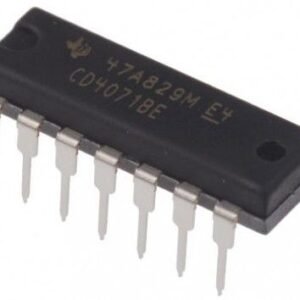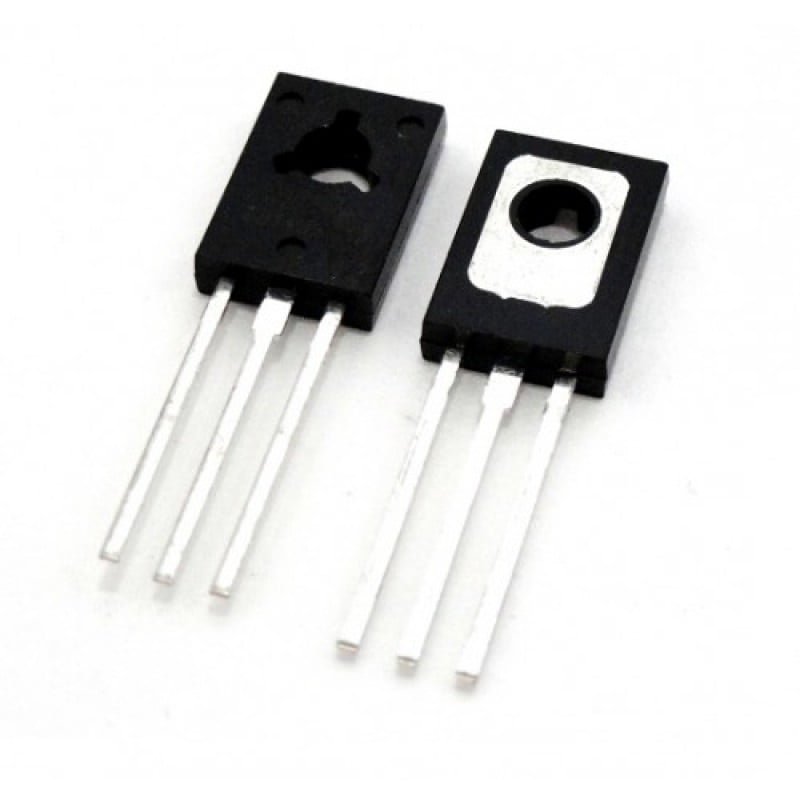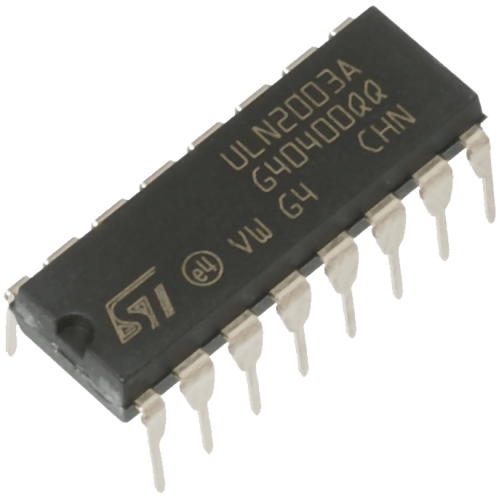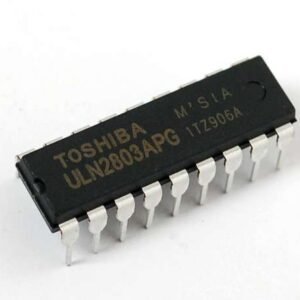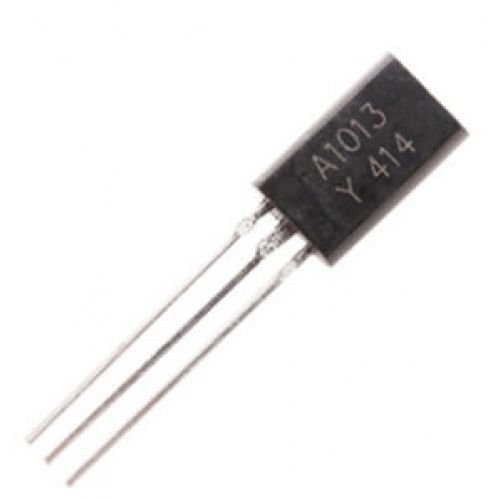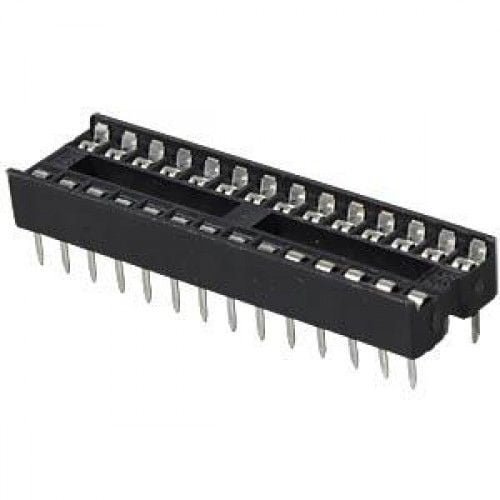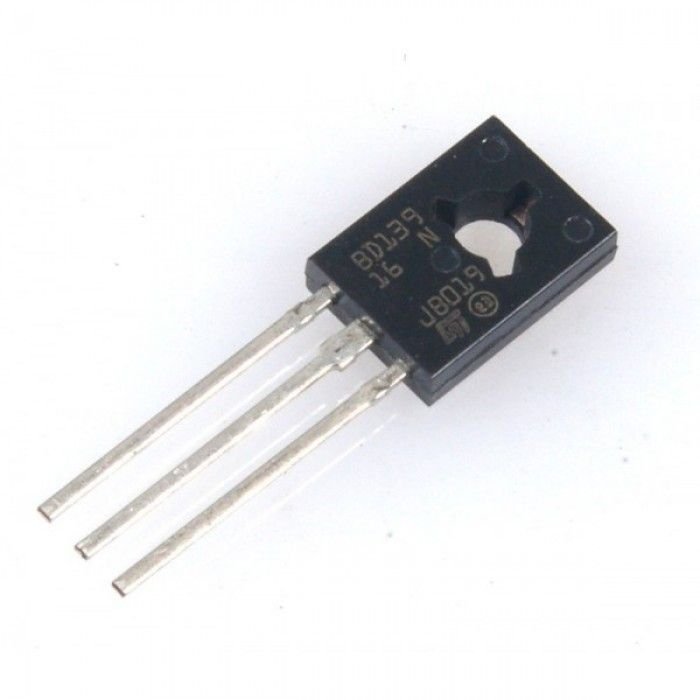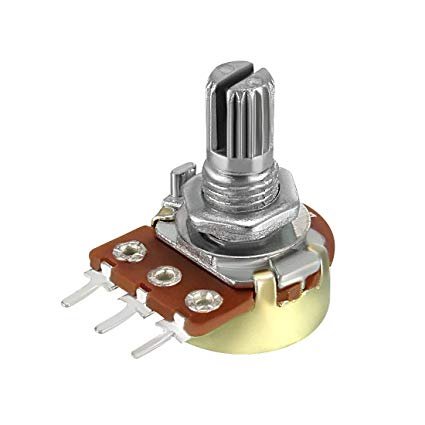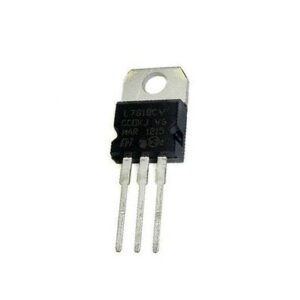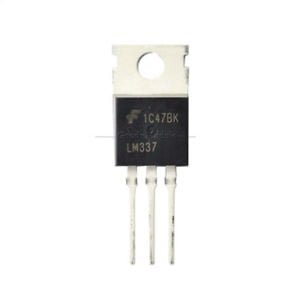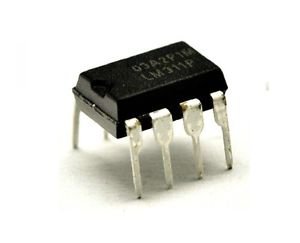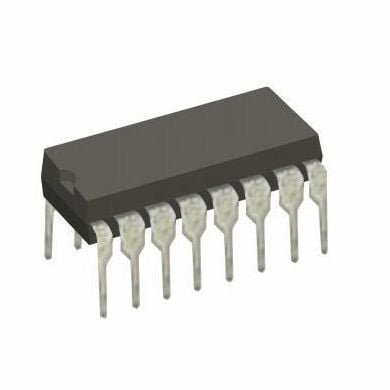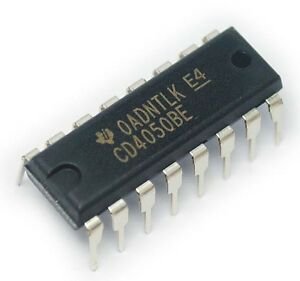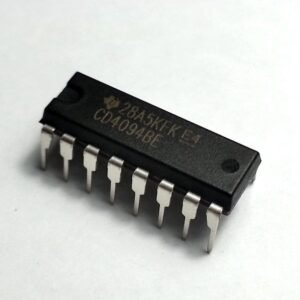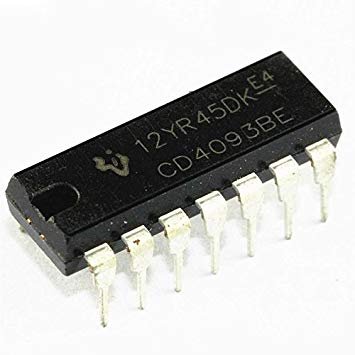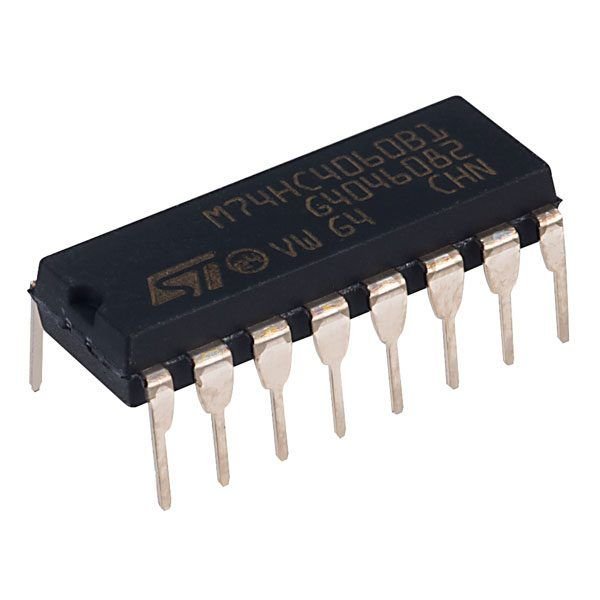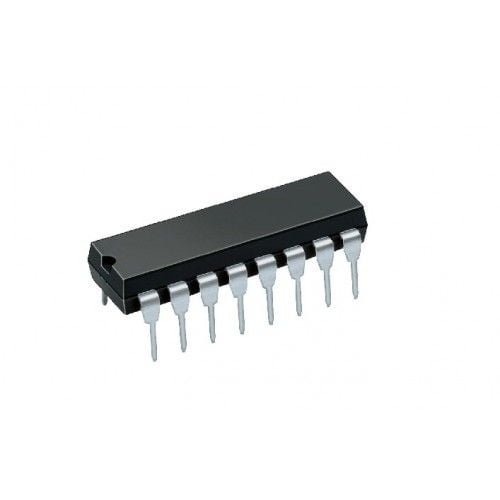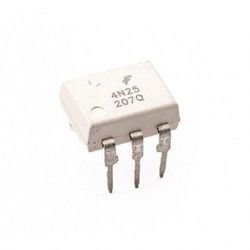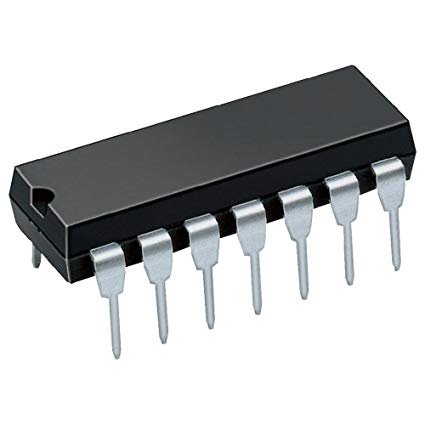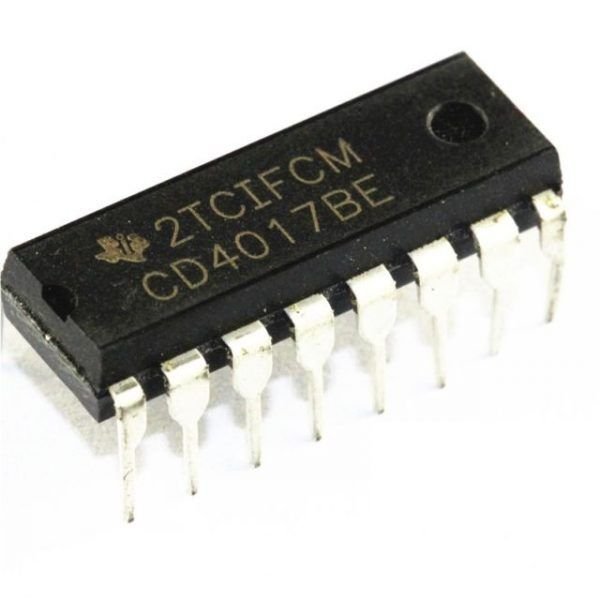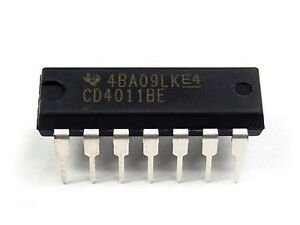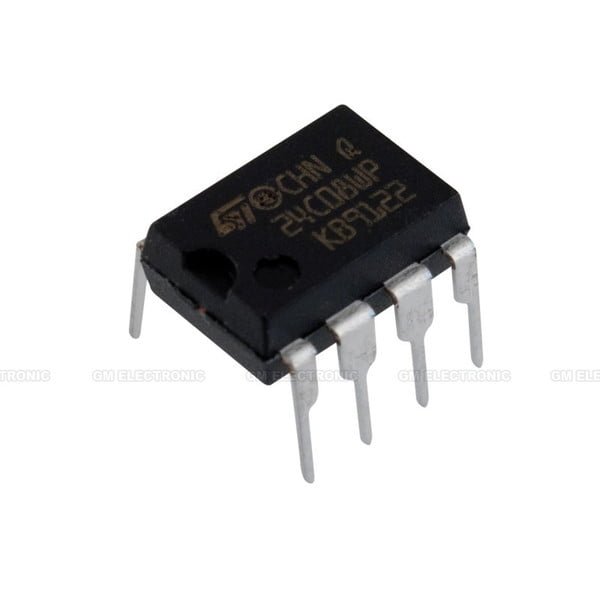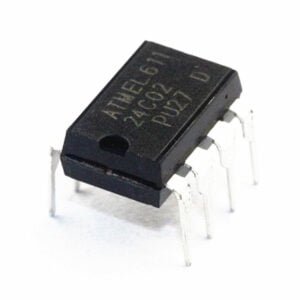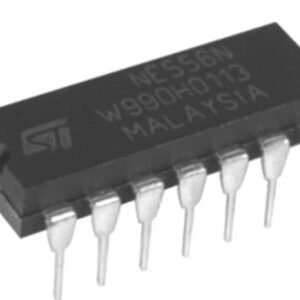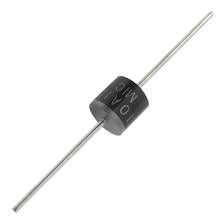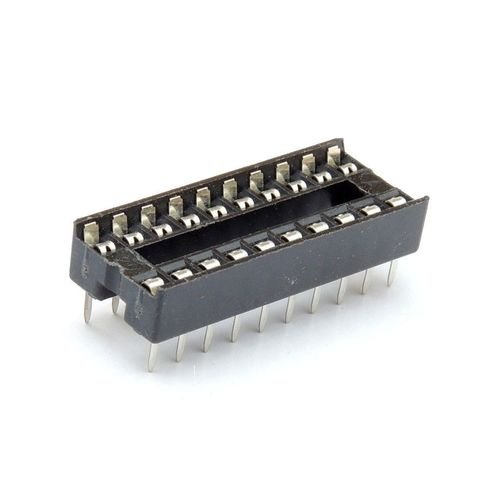-
- Dual Input IC with 4 OR Gates with an operating voltage range from 3V to 18V
- Fully Static and Medium Speed Operation: with tPHL, tPLH = 60ns (typ) at 10V
- DC input current: 10mA
- High-Voltage Type (20V Rating)
- Power Dissipation: 500mW
- Maximum propagation delay is 250ns.
- Standard symmetric output
- Minimum logic Low and High voltage @+5V is1.5V and 3.5V
- Maximum Transition Time is 200ns
-
- Bi-Polar PNP Transistor
- Continuous Collector current (IC) is -1.5A
- Collector-Emitter voltage (VCE) is- 80 V
- Collector-Base voltage (VCB) is- 80V
- Base Current (Ib) is -0.5A
- Emitter Base Breakdown Voltage (VBE) is -5V
- DC current gain (hfe) is 40 to 160
- Available in To-225 and SOT-32 Package
- Collector Dissipation: 12.5 W
- Operating Junction Temperature Max (Tj): 150°C
-
- Seven Darlingtons per package
- Output current 500 mA per driver (600 mA peak)
- Output voltage 50 V
- Integrated suppression diodes for inductive loads
- Outputs can be paralleled for higher current
- TTL/CMOS/PMOS/DTL compatible inputs
- Inputs pinned opposite outputs to simplify
-
ULN 2803 is a high-voltage, high-current Darlington transistor array. The device consists of eight npn Darlington pairs that feature high-voltage outputs with common-cathode clamp diodes for switching inductive loads. The collector-current rating of each Darlington pair is 500 mA. The Darlington pairs may be connected in parallel for higher current capability. Applications include relay drivers, hammer drivers, lamp drivers, display drivers (LED and gas discharge), line drivers, and logic buffers.
-
KBL406 5-600V 4A Bridge Rectifier
Original price was: ₨45.00.₨39.00Current price is: ₨39.00. Quick ViewBridge rectifier diode with a 4A current rating.
-
A potentiometer is a manually adjustable variable resistor with 3 terminals. Two terminals are connected to both ends of a resistive element, and the third terminal connects to a sliding contact, called a wiper, moving over the resistive element. The position of the wiper determines the output voltage of the potentiometer.
-
- Type Designator: 2SA1013
- Material of transistor: Si
- Polarity: PNP
- Maximum collector power dissipation (Pc), W: 0.9
- Maximum collector-base voltage Ucb, V: 160
- Maximum collector-emitter voltage Uce, V: 160
- Maximum emitter-base voltage Ueb, V: 6
- Maximum collector current Ic max, A: 2
- Maksimalna temperatura (Tj), °C: 125
- Transition frequency (ft), MHz: 15
- Collector capacitance (Cc), pF: 35
- Forward current transfer ratio (hFE), min: 60
- Noise Figure, dB: –
-
IC sockets are generally for preventing damage to IC’s from soldering and while testing multiple circuits. These are made from Black Thermoplastic and tin-plated alloy contacts. One end is notched to aid in identification. They can be mounted end to end to suit longer IC’s.
-
- Plastic casing NPN Transistor
- Continuous Collector current (IC) is 1.5A
- Collector-Emitter voltage (VCE) is 80 V
- Collector-Base voltage (VCB) is 80V
- Base Current (Ib) is 0.5A
- Emitter Base Breakdown Voltage (VBE) is 5V
- DC current gain (hfe) is 40 to 160
- Available in To-225 package
-
Variable resistor 50K Potentiometer / Variable Resistor
Original price was: ₨50.00.₨39.00Current price is: ₨39.00. Quick ViewVariable resistor 50K Potentiometer / Variable Resistor (50K Ohm) is a manually adjustable variable resistor with 3 terminals. Two terminals are connected to both ends of a resistive element, and the third terminal connects to a sliding contact, called a wiper, moving over the resistive element. The position of the wiper determines the output voltage of the potentiometer. The potentiometer essentially functions as a variable voltage divider. The resistive element can be seen as two resistors in series(potentiometer resistance), where the wiper position determines the resistance ratio of the first resistor to the second resistor. A potentiometer is also commonly known as a potentiometer or pot. The most common form of potmeter is the single turn rotary potmeter. This type of pot is often used in audio volume control (logarithmic taper) as well as many other applications. Different materials are used to construct potentiometers, including carbon composition, cermet, wirewound, conductive plastic or metal film.
-
1M Ohm Rotary Potentiometer / Variable Resistor
Original price was: ₨50.00.₨39.00Current price is: ₨39.00. Quick View1M Ohm Rotary Potentiometer / Variable Resistor is a manually adjustable variable resistor with 3 terminals. Two terminals are connected to both ends of a resistive element, and the third terminal connects to a sliding contact, called a wiper, moving over the resistive element. The position of the wiper determines the output voltage of the potentiometer. The potentiometer essentially functions as a variable voltage divider. The resistive element can be seen as two resistors in series(potentiometer resistance), where the wiper position determines the resistance ratio of the first resistor to the second resistor. A potentiometer is also commonly known as a potentiometer or pot. The most common form of potmeter is the single turn rotary potmeter. This type of pot is often used in audio volume control (logarithmic taper) as well as many other applications. Different materials are used to construct potentiometers, including carbon composition, cermet, wirewound, conductive plastic or metal film.
-
500K Ohm Rotary Potentiometer / Variable Resistor
Original price was: ₨50.00.₨39.00Current price is: ₨39.00. Quick View500K Ohm Rotary Potentiometer / Variable Resistor is a manually adjustable variable resistor with 3 terminals. Two terminals are connected to both ends of a resistive element, and the third terminal connects to a sliding contact, called a wiper, moving over the resistive element. The position of the wiper determines the output voltage of the potentiometer. The potentiometer essentially functions as a variable voltage divider. The resistive element can be seen as two resistors in series(potentiometer resistance), where the wiper position determines the resistance ratio of the first resistor to the second resistor. A potentiometer is also commonly known as a potentiometer or pot. The most common form of potmeter is the single turn rotary potmeter. This type of pot is often used in audio volume control (logarithmic taper) as well as many other applications. Different materials are used to construct potentiometers, including carbon composition, cermet, wirewound, conductive plastic or metal film.
-
A potentiometer is a manually adjustable variable resistor with 3 terminals. Two terminals are connected to both ends of a resistive element, and the third terminal connects to a sliding contact, called a wiper, moving over the resistive element. The position of the wiper determines the output voltage of the potentiometer. The potentiometer essentially functions as a variable voltage divider. The resistive element can be seen as two resistors in series(potentiometer resistance), where the wiper position determines the resistance ratio of the first resistor to the second resistor. A potentiometer is also commonly known as a potentiometer or pot. The most common form of potmeter is the single turn rotary potmeter. This type of pot is often used in audio volume control (logarithmic taper) as well as many other applications. Different materials are used to construct potentiometers, including carbon composition, cermet, wirewound, conductive plastic or metal film.
-
A potentiometer is a manually adjustable variable resistor with 3 terminals. Two terminals are connected to both ends of a resistive element, and the third terminal connects to a sliding contact, called a wiper, moving over the resistive element. The position of the wiper determines the output voltage of the potentiometer. The potentiometer essentially functions as a variable voltage divider. The resistive element can be seen as two resistors in series(potentiometer resistance), where the wiper position determines the resistance ratio of the first resistor to the second resistor. A potentiometer is also commonly known as a potentiometer or pot. The most common form of potmeter is the single turn rotary potmeter. This type of pot is often used in audio volume control (logarithmic taper) as well as many other applications. Different materials are used to construct potentiometers, including carbon composition, cermet, wirewound, conductive plastic or metal film.
-
A potentiometer is a manually adjustable variable resistor with 3 terminals. Two terminals are connected to both ends of a resistive element, and the third terminal connects to a sliding contact, called a wiper, moving over the resistive element. The position of the wiper determines the output voltage of the potentiometer. The potentiometer essentially functions as a variable voltage divider. The resistive element can be seen as two resistors in series(potentiometer resistance), where the wiper position determines the resistance ratio of the first resistor to the second resistor. A potentiometer is also commonly known as a potentiometer or pot. The most common form of potmeter is the single turn rotary potmeter. This type of pot is often used in audio volume control (logarithmic taper) as well as many other applications. Different materials are used to construct potentiometers, including carbon composition, cermet, wirewound, conductive plastic or metal film.
-
A potentiometer is a manually adjustable variable resistor with 3 terminals. Two terminals are connected to both ends of a resistive element, and the third terminal connects to a sliding contact, called a wiper, moving over the resistive element. The position of the wiper determines the output voltage of the potentiometer. The potentiometer essentially functions as a variable voltage divider. The resistive element can be seen as two resistors in series(potentiometer resistance), where the wiper position determines the resistance ratio of the first resistor to the second resistor. A potentiometer is also commonly known as a potentiometer or pot. The most common form of potmeter is the single turn rotary potmeter. This type of pot is often used in audio volume control (logarithmic taper) as well as many other applications. Different materials are used to construct potentiometers, including carbon composition, cermet, wirewound, conductive plastic or metal film.
-
A potentiometer is a manually adjustable variable resistor with 3 terminals. Two terminals are connected to both ends of a resistive element, and the third terminal connects to a sliding contact, called a wiper, moving over the resistive element. The position of the wiper determines the output voltage of the potentiometer. The potentiometer essentially functions as a variable voltage divider. The resistive element can be seen as two resistors in series(potentiometer resistance), where the wiper position determines the resistance ratio of the first resistor to the second resistor. A potentiometer is also commonly known as a potentiometer or pot. The most common form of potmeter is the single turn rotary potmeter. This type of pot is often used in audio volume control (logarithmic taper) as well as many other applications. Different materials are used to construct potentiometers, including carbon composition, cermet, wirewound, conductive plastic or metal film.
-
A potentiometer is a manually adjustable variable resistor with 3 terminals. Two terminals are connected to both ends of a resistive element, and the third terminal connects to a sliding contact, called a wiper, moving over the resistive element. The position of the wiper determines the output voltage of the potentiometer. The potentiometer essentially functions as a variable voltage divider. The resistive element can be seen as two resistors in series(potentiometer resistance), where the wiper position determines the resistance ratio of the first resistor to the second resistor. A potentiometer is also commonly known as a potentiometer or pot. The most common form of potmeter is the single turn rotary potmeter. This type of pot is often used in audio volume control (logarithmic taper) as well as many other applications. Different materials are used to construct potentiometers, including carbon composition, cermet, wirewound, conductive plastic or metal film.
-
- Technology Family: CD4000
- VCC (Min) (V): 3
- VCC (Max) (V): 18
- Channels (#): 4
- Inputs per channel: 2
- IOL (Max) (mA): 6.8
- IOH (Max) (mA): -6.8
- Input type Standard: CMOS
- Output type: Push-Pull
- 5V–10V–15V parametric ratings
- Symmetrical output characteristics
- Speed: (tpd > 50ns)
- Data rate (Max) (Mbps): 8
- Rating: Catalog
- Operating temperature range (C): -55 to 125
-
- Ultra Low Power Consumption 0.7 μA
- Wide Range of Supply Voltages 2V to 8V
- Input Common-Mode Range Beyond V+ and V−
- Open Collector and Push-Pull Output
- High Output Current Drive: (@ VS = 5V) 45 mA
- Propagation Delay (@ VS = 5V, 10 mV Overdrive) 25 μs
- Tiny 5-Pin SOT-23 Package
- Latch-up Resistance >300 mA
- LMC7215-Q1 is an Automotive Grade Product that is AEC-Q100 Grade 3 Qualified.
-
- 24V Positive Voltage Regulator
- Minimum Input Voltage is 33V
- Maximum Input Voltage is 40V
- Output Current: 1.5 A
- Internal Thermal Overload and Short circuit current limiting protections are available.
- Junction Temperature maximum of 125 degree Celsius
- Available in TO-220, TO-3 and KTE package
-
- Output voltage tolerances of ±2% at Tj = 25˚C and ±4% over the temperature range (LM340A)
- Line regulation of 0.01% of VOUT/V of ∆VIN at 1A load (LM340A)
- Load regulation of 0.3% of VOUT/A (LM340A)
- Internal thermal overload protection
- Internal short-circuit current limit
- Output transistor safe area protection
- P+ Product Enhancement tested
-
- 12V Negative Voltage Regulator
- Minimum Input Voltage is -14.5V
- Maximum Input Voltage is -27V
- Peak Output Current is 2.2A
- Average Output Current is upto 1A
- Internal Thermal Overload and Short circuit current limiting protection is available.
- Available in TO-220 package only.
-
- 5V Negative Voltage Regulator
- Output Voltage: -5V
- Output Current: 1.5A
- Minimum Input Voltage is 7V
- Maximum Input Voltage is 25V
- Operating current(IQ) is 5mA
- Internal Thermal Overload and Short circuit current limiting protection is available.
- Junction Temperature maximum 125 degree Celsius
- Available in TO-220 and KTE package
-
7812 is a 12V Voltage Regulator that restricts the voltage output to 12V and draws 12V regulated power supply. The 7812 is the most common, as its regulated 12-volt supply provides a convenient power source for most TTL components. Output Voltage:12V. Output Current:1A. Input Voltage: 14.6 – 35VDC.
-
- 9V Positive Voltage Regulator
- Minimum Input Voltage is 11V
- Maximum Input Voltage is 35V
- Output Current: 1.5 A
- PSRR / Ripple Rejection: 55 dB
- Output Type: Fixed
- Internal Thermal Overload and Short circuit current limiting protection is available.
- Junction Temperature maximum of 125 degree Celsius
- Available in TO-220, TO-3 and KTE package
-
- Input Voltage range: 8V to 25V
- Output Voltage: 5.75V(min) – 6.25V(max)
- Output Current: 1A
- Peak current: 2.2A
- Operating Temperature : 0 to +125 C
- Polarity: Positive
-
LM-337 LM337 Variable Negative -VE Voltage Regulator IC
Original price was: ₨65.00.₨39.00Current price is: ₨39.00. Quick View- Used for Positive voltage regulations
- Variable power supply
- Current limiting circuits
- Reverse polarity circuits
- Commonly used in Desktop PC, DVD and other consumer products
- Used in motor control circuits
-
- Operates from single 5V supply
- Input current: 150 nA max. over temperature
- Offset current: 20 nA max. over temperature
- Differential input voltage range: 30V
- Power consumption: 135 mW at 15V
- Available in Q-Temp Automotive
- High-Reliability Automotive Applications
- Configuration Control and Print Support
- Qualification to Automotive Standards
-
The 74LS139 is a high speed Dual 1-of-4 Decoder/De-multiplexer. The device has two independent decoders, each accepting two inputs and providing four mutually exclusive active LOW Outputs. Each decoder has an active LOW Enable input which can be used as a data input for a 4-output demultiplexer. Each half of the LS139 can be used as a function generator providing all four minterms of two variables. The LS139 is fabricated with the Schottky barrier diode process for high speed and is completely compatible with all Motorola TTL families.
-
The CD4050 hex buffers are monolithic complementary MOS (CMOS) integrated circuits constructed with N- and P-channel enhancement mode transistors. These devices feature logic level conversion using only one supply voltage (VDD). The input signal high level (VIH) can exceed the VDD supply voltage when these devices are used for logic level conversions. These devices are intended for use as hex buffers, CMOS to DTL/ TTL converters, or as CMOS current drivers, and at VDD = 5.0V, they can drive directly two DTL/TTL loads over the full operating temperature range.
-
- High Voltage Type (20V Rating)
- 3-State Parallel Outputs for Connection to Common Bus
- Separate Serial Outputs Synchronous to Both Positive and Negative Clock Edges for Cascading
- Medium Speed Operation – 5MHz at 10V (typ)
- Quiescent Current at 20V
- Maximum Input Current of 1A at 18V Over Full Package Temperature Range; 100nA at 18V and +25oC
- Noise Margin (Over Full Package/Temperature Range) – 1V at VDD = 5V – 2V at VDD = 10V – 2.5V at VDD = 15V
- 5V, 10V and 15V Parametric Ratings
-
- Operating Voltage: 5V, 10V, 15V DC
- Maximum Input Current: 1uA
- Hysteresis Voltage Typically 0.9 V at VDD: 5 V and 2.3 V at VDD: 10 V
- Noise Immunity Greater Than 50%
- Unlimited input rise and fall times
-
- High Speed Binary Ripple Carry Counter
- Separate Reset Input Pin
- Wide Operating Voltage Range: 2.0 to 6.0 V
- Output Drive up to 10 LS-TTL Loads
- Equivalent to CD4060
-
The MC34063A Series is a monolithic control circuit containing the primary functions required for dc-to-dc converters. These Buck Boost Inverting Switching Regulators consist of an internal temperature compensated reference, comparator, controlled duty cycle oscillator with an active current limit circuit, driver and high current output switch. Operation from 3.0 V to 40 V Input. Output Switch Current to 1.5 A.
-
This is a monostable multivibrator or pulse generator.
-
This thyristor is intented for use in applications requiring good bidirectional blocking voltage capability, high surge current capability and high thermal cycling performance.
-
The 4N25 is an optocoupler for general purpose applications. It contains a light emitting diode optically coupled to a photo-transistor.
-
The CD4024 is a 7-stage ripple-carry binary counter. Buffered outputs are externally available from stages 1 through 7. The counter is reset to its logical 0 stage by a logical 1 on the reset input. The counter is advanced one count on the negative transition of each clock pulse.
-
- The supply voltage of IC 4017 ranges from 3V to 15V, usually +5V
- This IC is well-matched with Transistor-Transistor Logic or TTL.
- The operational speed/CLK speed of this IC is 5 MHz.
- It provides support to10 outputs that are decoded.
- It is available in different packages like 16-pin GDIP, PDIP & PDSO
- Input high time 30 ns
- Output current is 10 mA
- Noise immunity is high typically 0.45 VDD
- Operation is completely static
- Low power like 10 W
- Speed operation is medium like 5.0 MHz with 10V VDD
- Input Voltage or Vin ranges from 0.5 VDC to VDD +0.5 VDC
- TS or Storage Temperature ranges from 65C to +150C
- VDD or DC Supply Voltage ranges from 0.5 VDC to +18 VDC
- PD or Power Dissipation is Dual-In-Line is 700 mW
- TL or Lead Temperature is 260C
-
- Asynchronous Set-Reset Capability
- Static Flip-Flop Operation
- Medium-Speed Operation: 16 MHz (Typical) Clock Toggle Rate at 10-V Supply
- Standardized Symmetrical Output Characteristics
- Maximum Input Current Of 1- A at 18 V Over Full Package Temperature Range:
- 100 nA at 18 V and 25C
- Noise Margin (Over Full Package Temperature Range):
- 1 V at VDD = 5 V
- 2 V at VDD = 10 V
- 2.5 V at VDD = 15 V
-
- Dual inputQuad NAND gate operation.
- Input voltage range: -0.5 to VDD +5V
- Power dissipation of 100mW per logic change.
- It is available in different outline packages
- The propagation delay time is 60ns
- All input and output pins are buffered for high throughput
- The output characteristics are standardized symmetric
- CD4011 draws a maximum input current of 1 Ampere at 18 volts
- Offers different noise margin level according to the input voltage level
- Temperature operating range is -55C to +125C
-
The M24C08 is an 8-Kbit I2C-compatible EEPROM (Electrically Erasable PROgrammable Memory) organized as 1 K 8 bits. It operate with a clock frequency of 400 kHz.
-
- Low-voltage and Standard-voltage Operation
- 2.7 (VCC = 2.7V to 5.5V)
- 1.8 (VCC = 1.8V to 5.5V)
- Internally Organized 128 x 8 (1K), 256 x 8 (2K), 512 x 8 (4K),
- 1024 x 8 (8K) or 2048 x 8 (16K)
- Two-wire Serial Interface
- Schmitt Trigger, Filtered Inputs for Noise Suppression
- Bidirectional Data Transfer Protocol
- 100 kHz (1.8V) and 400 kHz (2.7V, 5V) Compatibility
- Write Protect Pin for Hardware Data Protection
- 8-byte Page (1K, 2K), 16-byte Page (4K, 8K, 16K) Write Modes
- Partial Page Writes Allowed
- Self-timed Write Cycle (5 ms max)
- High-reliability
- Endurance: 1 Million Write Cycles
- Data Retention: 100 Years
- Automotive Devices Available
- 8-lead JEDEC PDIP, 8-lead JEDEC SOIC, 8-lead Ultra Thin Mini-MAP (MLP 2×3), 5-lead SOT23, 8-lead TSSOP and 8-ball dBGA2 Packages
- Die Sales: Wafer Form, Waffle Pack and Bumped Wafers
- Low-voltage and Standard-voltage Operation
-
- A dual version of NE556 consists of two precision timers that operate in both monostable and astable modes.
- It is specified for operation from 4.5 V to 16 V.
- TTL compatible output which can source or sink current of up to 150mA.
- Adjustable duty cycle.
- It can produce a timing delay from microseconds to hours.
- The operating temperature range is from 0 to 70 degrees Celsius.
- It has temperature stability better than 0.005% per C.
-
- Microcontrollers I/O switching
- VoIP phones
- Signal isolation
- PC communications
-
10A10 10 AMP 1000V 10A 1KV AXIAL RECTIFIER DIODE
Original price was: ₨45.00.₨30.00Current price is: ₨30.00. Quick ViewThe 10A10 diode is one of the family of popular 10A (ampere) general-purpose silicon diodes commonly used in AC adapters for high power devices. Blocking voltage varies from 1000 to 10,000 volts.
Features
- Low forward voltage drop
- High current capability
- High reliability
- High surge current capability
-
IC sockets are generally for preventing damage to IC’s from soldering and while testing multiple circuits. These are made from Black Thermoplastic and tin-plated alloy contacts. One end is notched to aid in identification. They can be mounted end to end to suit longer IC’s.

